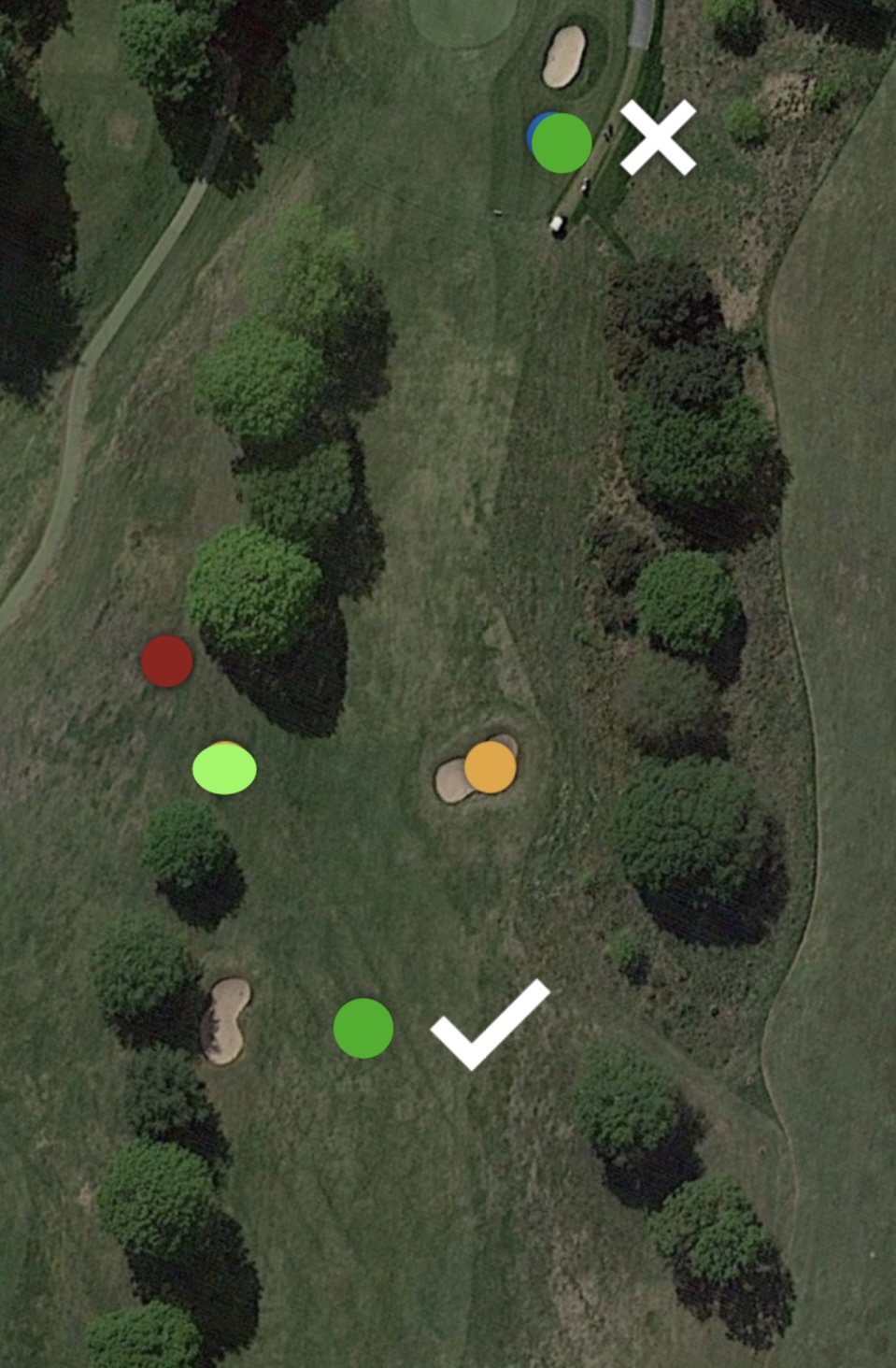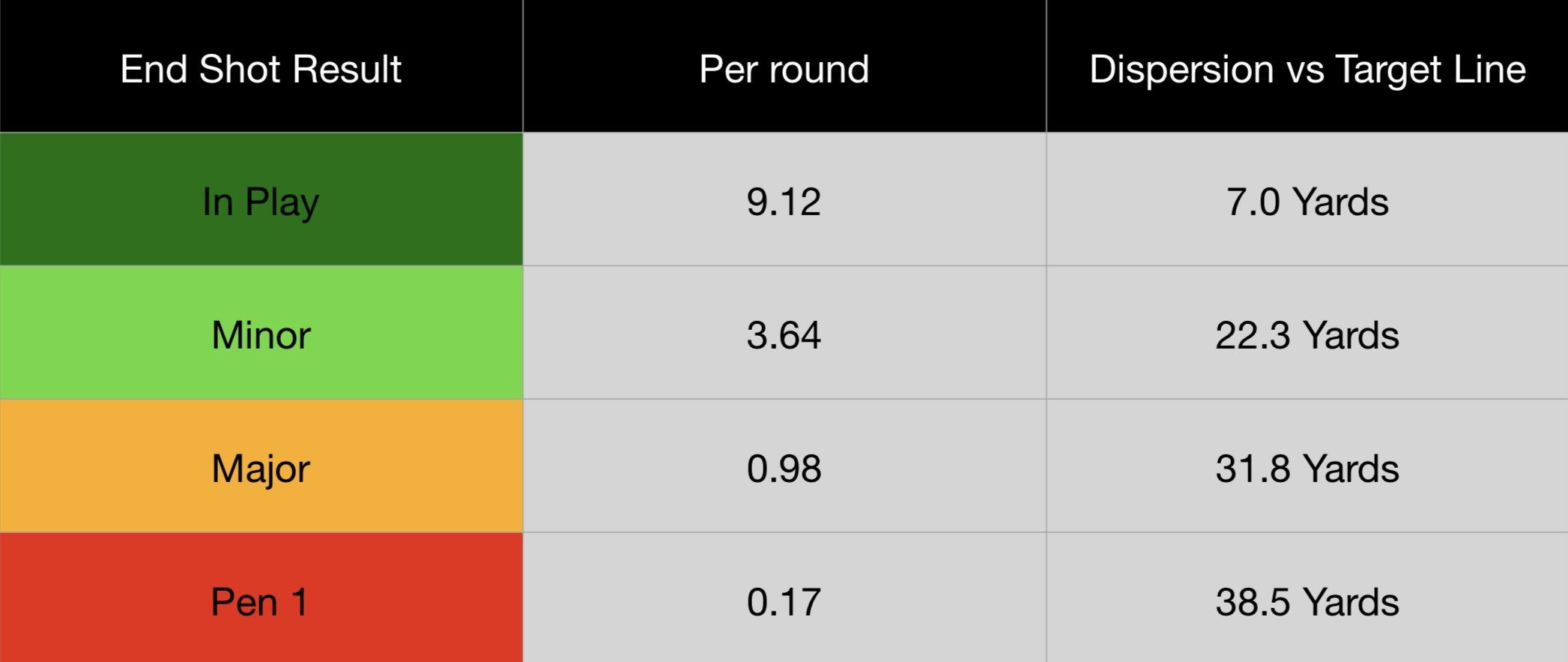Less ‘Majors’ to get to the Majors
In Play, Minor, Major and Penalty. For current Upgame Pro clients these metrics will be all too familiar. For our new users in 2023, these are the unique end shot results for all tee shots within the Pro version of Upgame. For this post, we looked at over 17,000 tee shots from players across the DP World and PGA tours to see how these metrics have an effect on scoring, but first let’s discuss why we have these metrics.
Ultimately the end shot result is to put an extra, more in depth layer of analysis to a players tee shot data, as opposed to just fairway’s hit or missed or relying on strokes gained. One of the primary reasons behind this is that fairway widths, rough difficulty and miss types can vary greatly week to week.
Misses are not always equal
The image below gives a clear indication on the importance of quantifying the end result of your shot, as misses can vary greatly.
If we take the two dark green dots, both are ‘In Play’ but traditionally the one further back would be rewarded as a fairway hit, with the ball greenside being classed as a missed fairway. I know which one I’d rather have!
The light green dot (Minor) is in the rough but is able to shape the ball round the tree to the green Vs the orange dot (Major) is in a pot bunker and only able to advance the ball forward. The red dot (Pen1) has had to take an unplayable drop from the trees.
Golf is so variable and so are the types of misses you will have in a round which will play a big factor in how you score. A player who has a driving accuracy of 57% which is made up by 8 fairways with 6 minor’s will likely score much better than a player who hits 11 fairways with 2 penalty misses and 1 major.
Strokes gained has helped combat this but how you make up your SG off the tee can also be somewhat unknown. Unless you are playing on tour, your strokes gained will be against the raw benchmark and won’t be adjusted vs the field. Factors such as weather, course conditions and distance will all greatly affect your strokes gained and not necessarily tell you the whole story.
A player who has a driving accuracy of 57% which is made up by 8 fairways and 6 minor’s will likely score much better than a player who hits 11 fairways with 2 penalty misses and 1 major.
Course types will have a say.
If we look at two extreme examples, only one player in the top 10 at this year’s Open Championship at St.Andrews hit less than 60% of fairways (ironically an Upgame client), whilst six players in the top 10 of the Andalucia Masters at Valderrama were less than this number. No surprises here due to the nature of the two courses, but it shows straight away analysing a players tee shot performance solely on driving accuracy will not tell the whole story.
At The Old Course, 60% ranked 67th in driving accuracy, whilst at Valderrama the same number ranked 24th. Simply put, some courses are just easier to hit more fairways than others.
If we take this simple image below, both tee shots have finished 5 yards off the fairway, however missing a 45Y wide fairway is much greater than missing a 25Y wide target.
This is why Upgame Pro has two additional metrics to add to traditional driving stats. The end shot result, and measuring vs the players intended target line (Image left) which we will discuss in a future post.
What are Upgame Pro’s end shot result metrics?
In Play = A good drive. Somewhere where the player has a clear, unaffected shot to the green. This doesn’t necessarily have to be the fairway. Think, a drivable par 4 where a player may hit a perfect tee shot into the green side rough leaving a simple up and down. Or a tough hole with a penalty zone up the right hand side with wind off the left, a tee shot in the left semi maybe ‘in play.’
Minor = Somewhere where you have a clear shot to the green but have lost an element of control. This maybe a shallow fairway bunker where strike becomes more difficult, or the 2nd cut of rough where controlling distance and spin is a factor.
Major = Effectively half a shot penalty. Thick rough and unable to reach the green, trees where you can only advance the ball forward or for those who play links golf, pot bunkers!
Penalty 1 = As it sounds, a penalty shot such as water hazard or penalty drop. (Note Penalty 2 is for OOB in the app but will not be used for this post)
The table below compares a world top 25 player vs other Upgame tour clients and shows the fine line in both driving accuracy and end shot results. Note the ‘In play’ metric is 9% higher than the driving accuracy. (Not all good drives have to be on the fairway remember!)
It is also important to consider the higher up the world rankings a player gets, arguably the tougher the course set ups become in the tournaments they play.
How is scoring affected by the end shot result?
Of the 17387 tee shots we analysed, there are noticeable differences in both strokes gained and in scoring vs the end shot result. Graph 1 shows the raw strokes gained per shot of the different type of misses, with only shots finishing In play having a positive strokes gained. Major misses lost close to half a shot with penalty misses losing just over 1 stroke. Not surprisingly this highlights the importance of keeping major misses or worse to a minimum.
Graph 2 below is the average score per hole vs the end shot result and surprisingly only tee shots that finished In Play averaged under par. Minor misses were just above par, whilst Major and Penalty misses had a severe impact and averaged +0.73 and +1.27 per hole respectively.
Tight dispersion to keep the Major’s to a minimum!
We know the importance of reducing a Major miss or worse is paramount to good scoring, especially at the highest level but how many of these misses do elite tour plays have per round and what is their dispersion vs their intended target line in relation to their end shot result?
The table above gives a clear image of the dispersion even top tour players have with a poor tee shot, with Major or penalty misses averaging more than 30 yards from their intended target line. Quite the miss! However they keep these misses to less than 10% per round (1.15 per round) giving themselves plenty of opportunities to score well when they are in play. It also confirms that missing a fairway is not always a bad thing. The average fairway % of the 17,000 tee shots was 56.04% yet the In Play metric was 64.8%.
The honesty from the top players when they or their caddies enter their data is also worth noting. Often we see Upgame users being too generous in their end shot results and classing a true minor as in play or a major as a minor. Use the descriptions of the end shot results set out earlier in this post to be as accurate as possible when entering your data, and compare how you rank vs the elite tour player.
Upgame, know your game.







